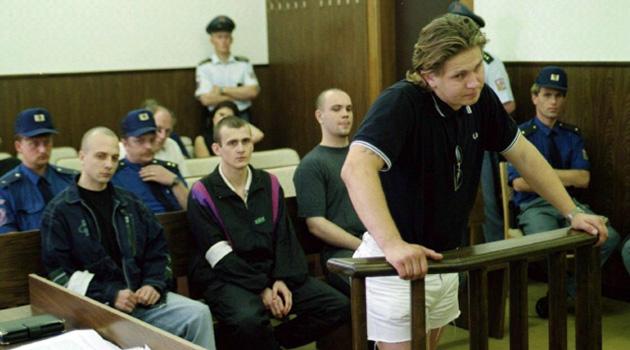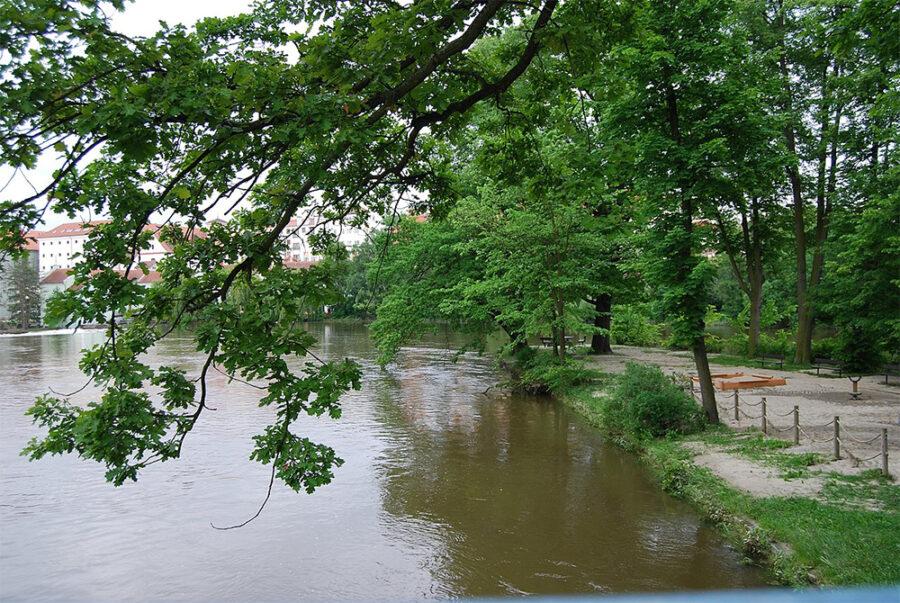Thirty years ago, Tibor Danihel was murdered because of his race: How the Czech justice system and the media dealt with that kind of violence

It has been 30 years since one of the racist murders that moved all of Czech society took place. The media learned a lot from reporting this case, unlike the justice system, which was essentially insensitive when it came to crimes motivated by racism - when it wasn't playing directly into the hands of the perpetrators.
What is the life of a Romani youth worth?
On Friday, 24 September 1993, a large group of skinheads drove four Romani youths into the Otava River in Písek and used force to prevent them from getting out of the water. One of the Roma was 18-year-old Tibor Danihel, who drowned as a result. The incident was tried before the courts many times and the legal qualification of the crime and the number of defendants changed more than once before a verdict that was at least somewhat adequate resulted. The harshest sentence for this racist murder was a little more than eight years in prison – that was how much the Czech justice system thought the life of a Romani boy was worth in the 1990s.
An unfortunate accident?
In one of the first reports on the death of Tibor Danihel, the daily Lidová demokracie [People’s Democracy] under the headline “Death after a skinhead march” relayed the following: ” ‘The atmosphere in the town is not good and I would rather not comment on the case in more detail as the police are still investigating,’ Mayor of Písek Tom Zajíček told the LD correspondent yesterday… ‘It is not yet clear whether the group came intentionally to Písek for this purpose or whether this was an unfortunate accident. Just a very few individuals in Písek are members of the skinhead movement.’ Yesterday representatives of the Písek town hall met with Romani families to aid them with preserving the peace, as that will contribute to the case being investigated quickly.” – (tš, LD 28. 9. 93, p. 6.)

He “tragically perished under unpleasant circumstances…”
From the beginning, the news reports about the incident did not go beyond the customary framework of the daily papers’ crime sections. The framing was that of “local Roma” on the one hand and “skinheads” on the other. The reporting on the funeral of the deceased was also done in that spirit. The Agricultural News (Zemědělské noviny) wrote the following in an article called “Funeral without provocations”:
“Yesterday in Písek a cimbalom ensemble was part of the procession of those paying their last respects to the 18-year-old Romani youth Tibor Daniel, who tragically perished under unpleasant circumstances last week… According to the Mayor of Písek, Tom Zajíček, the case is decidedly not to be seen as proof of any kind of escalated racial hatred. That was confirmed by the calm, dignified course of the funeral yesterday.” (bm, ZN 2. 10. 1993, p. 3.)
A “clash” between “two hostile groups”
Anna Šabatová, Jiří Homoláč and Kamila Karhanová, authors of the study called “The image of Roma in the Central European mass media after 1989” [Obraz Romů v středoevropských masmédiích po roce 1989], wrote the following in their analysis of the case:
“The forming of the image of the Písek case by the media is marked by several features typical of the attitude of the Czech media toward violent crimes when the perpetrators are members of the majority society and Romani people are the victims. Given that the Roma and the skinheads are seen as two hostile groups which are constantly in conflict with each other, the mere coincidence of these two categories ensures, in the news reporting about events like the death of Tibor Danihel, that there will be sufficient coherence to render them ‘meaningful’… Presenting the death of the boy as a victim of a clash between two hostile parties, however, obscures the causal connection between the actions of the skinheads and the death of their victim.”
“Try to kill a Gypsy”
Those who took an interest in racist crime and in aiding the victims of such crime, above all the activists Markus Pape and Jakub Polák, helped change the approach of Czech society to such events, first and foremost the approach of the local media and of both local and national politicians. Their efforts were also supported in the media by several columnists and commentators.
Ivan Gabal, the sociologist, published the following commentary in the daily Mladá fronta DNES with the headline “Try to kill a Gypsy”:
“In Písek, at the court, they advise you: There have to be a lot of you, shave your heads and cover your faces. Don’t touch the Gypsies. It’s enough to drive them into some deep water. […] During the trial, intimidate the witnesses, lie, invoke collective responsibility, become a patriot. The worst that will happen is you get probation. If there are enough of you, during one year you will cleanse even a medium-sized town. I have been observing how real life has been writing this script for the last two years. It was just a matter of time before somebody gave their blessing to it. […] What about the state? There are the still-open cases of the Molotov cocktails thrown into a Romani home and of the fascist spree in Terezín… there are the covertly racist, insensitively populist remarks by the Mayor of Prague during his campaign… the re-classifications of such racist attacks as misdemeanors… Czech politics simply supports the sense of a cultural closing off from others, of an ethnocentricity that opens the way to intolerance and racism.” (MfD 6. 12. 1994, p. 12.)
Czech President Václav Havel traveled to South Bohemia in November 1996 and, at the place where Mr. Danihel drowned, symbolically threw seven white roses into the river. “I am rather disquieted by the fact that after such a long time it is not yet possible to state unequivocally what actually happened, who is to blame, and to punish that person. Everything indicates this Romani youth became the victim of racism,” he said on that occasion.
The victim’s mother: “They didn’t kill a hen, they killed a human being”
This racist murder showed the state of the Czech justice system at the time very well, its unwillingness to acknowledge that the crimes committed against Romani people (as well as some foreign nationals) here were racist. The 1990s unfolded in the spirit of a different standard of measurement for crimes committed by ethnic Czechs and ethnic Roma. Ethnic Czech perpetrators were clearly protected by the justice system, and that persists to this day.
In December 1994, the sentences given to two of the skinheads were those of probation for the charge of rioting, while the rest were acquitted!
In the beginning, 16 assailants were accused in this case. The first-instance verdict was handed down by the District Court in Písek. The case was next covered by the media 15 months later, when the District Court in Písek heard the lawsuit of the prosecutor against the 16 skinheads for committing felony violence against members of a group in the population and supporting a movement aiming to suppress civil rights and freedoms (para. 260 of the Penal Code). Allegedly, the prosecutor in Písek was the first in the republic to make use of that statute, but he was unsuccessful. In December 1994, the sentences given to two of the skinheads were those of probation for the charge of rioting, while the rest were acquitted!
All of the dailies included brief recapitulations of what had happened in Písek in September 1993 in their news reporting. The Agricultural News, the tabloid Blesk, the Czech News Agency wire service (ČTK), the Daily Telegraph (Denní telegraf) and Mladá fronta DNES, even after the trial, reiterated the old version of the story, that the Romani youths jumped into the river, and one drowned.
Two circumstances from the course of the trial which the press recorded are worth mentioning. First and foremost was the argument of the defense that just before he died, Mr. Danihel had been using toluene, which allegedly could have influenced his behavior. (The idea of the “Romani guy on drugs” who basically caused his own death had been applied by the defense in other trials, although those cases had been based on 10 times the amount of toluene residue discovered during the autopsies of the victims).
The second circumstance was that Mr. Danihel’s mother was removed from the courtroom for “constantly disrupting” the proceedings, as the news reporting of ČTK and most of the dailies about the course of the trial put it. The exceptions were the Lidové noviny newspaper, which reported how the mother disagreed with the verdict, and the report published in the daily Práce [Labor], which actually quoted what she said : “They didn’t kill a hen, they killed a human being. I want justice.”
Epilogue
The appellate court verdict could only be changed by the Supreme Court on the basis of a complaint that the law had been violated, which would have to be filed by then-Justice Minister Vlasta Parkanová. She filed such a complaint at the request of the Senate, drafted by then-Senator Pavel Rychetský, who would go on to become President of the Constitutional Court in 2003. The Supreme Court overturned all of the verdicts from the lower instance and said the misconduct in the case had been committed by the police when they did not properly ascertain the identities of all the eyewitnesses at the crime scene. A new trial took place in October 1998 and the final verdict was handed down by the High Court on 30 June 1999.
In other words, almost six years after this crime was committed, the High Court found three defendants guilty of racially-motivated murder and attempted murder. Jaroslav Churáček got eight years and three months, Zdeněk Habich got seven years and six months, and Martin Pomije got six years and six months. A fourth defendant, Milan Brat, was acquitted in a separate proceedings in the year 2000.
When delivering the verdict, the presiding judge said many more skinheads had apparently contributed to the death of Mr. Danihel. The convicts responded to that by shouting: “Jewish Bolshevist politics!” and “Our thanks to the Czech nation!”